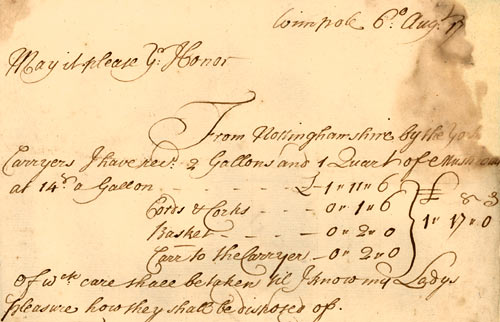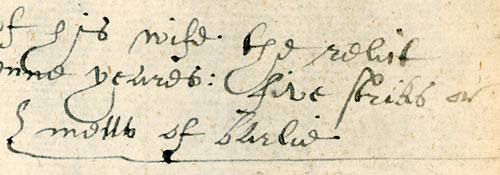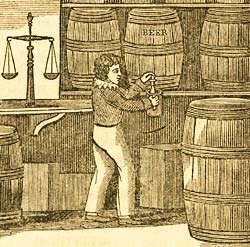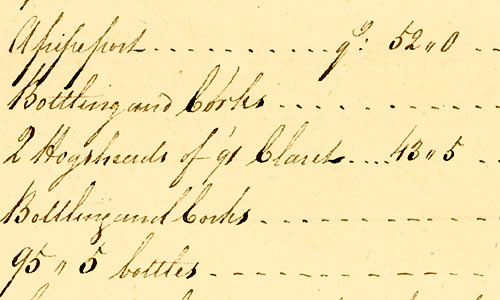Volumes or Capacity
Many commodities were sold according to their volume or capacity, rather than according to their weight. Volumes described here were used to measure both dry goods (grains etc.), and liquids. The basic unit of volume in England and Wales was the gallon.
What exactly was a gallon?
There were actually various different gallon measurements in existence in England and Wales. You used a different gallon depending on what it was you were measuring. The traditional corn gallon used to measure dry goods, as defined in 1696 and known as the 'Winchester Measure', measured 268.8 cubic inches. There was also an ale gallon, measuring 282 cubic inches, and a wine gallon measuring 231 cubic inches.
This proposal for pipe-laying, referring to gallons of water, but specifying that the Winchester Measure was to be used, is dated 1723.

Detail from proposal for pipe-laying, 1723 (Pl C 1/389)
It can seem surprising that commodities now measured by weight were often measured by volume in the past. This letter refers to 'two gallons and one quart of mushrooms' received by John Cossen, agent to the Earl of Oxford in 1724.

Detail from letter from John Cossen, 1724 (Pl C 1/468)
In 1824 the government abolished all existing gallon measurements and substituted a new, standard, Imperial gallon of 277.42 cubic inches, to come into effect on 1 January 1826. The Imperial gallon was able to hold ten avoirdupois pounds of water at a temperature of 62 degrees Fahrenheit. The capacities of the other measurements of volume were adjusted to take account of this new gallon.
Researchers should be aware that many specialist terms were used to describe quantities of particular goods or commodities. Vocabulary also varied between different regions of the British Isles. Dictionaries and specialist works on archaic weights and measures should be consulted by researchers who come across measurements not given here.
Liquids up to 1 pint
| Measure |
Equivalent |
| 20 minims |
1 fluid scruple |
| 3 fluid scruples |
1 fluid drachm |
| 8 fluid drachms |
1 fluid ounce (fl. oz.) |
| 5 fluid ounces |
1 gill |
| 4 gills (20 fluid ounces) |
1 pint |
Dry goods and liquids up to 1 gallon
| Measure |
Equivalent |
| 4 gills |
1 pint |
| 2 pints |
1 quart |
| 4 quarts |
1 gallon |
Once above a gallon, various different units of volume were used depending on the type of commodity being measured. The actual measurements contained in each unit of volume or capacity also varied over time.
Dry Goods measurements
Standard measurements:
| Measure |
Equivalent |
| 2 gallons |
1 peck |
| 4 pecks |
1 bushel |
| 2 bushels |
1 strike or raser |
| 8 bushels |
1 quarter |
| 5 quarters (40 bushels) |
1 load or wey |
| 2 weys (80 bushels) |
1 last |
Some commodities, such as coal, were sold as 'heaped' measures. They used the following additional measurements:
| Measure |
Equivalent |
| 3 bushels |
1 sack or bag |
| 12 sacks (36 bushels) |
1 chaldron |
In this example from the Archdeaconry of Nottingham Presentment Bills, dated 1622, a parishioner is presented for failing to provide for the parish clerk 'five striks or metts of barlie'. A 'met' is an archaic or dialect term for a measure. Users should be aware that non-standard terms are often used in original documents.

Detail from Presentment Bill, Sutton-on-Trent, 1622 (AN/PB 326/3/37)
Ale, Beer and Porter measurements
1688-1803
| Measure |
Equivalent |
| 8½ gallons |
1 firkin |
| 2 firkins |
1 kilderkin |
| 2 kilderkins |
1 barrel |
| 1½ barrels (51 gallons) |
1 hogshead |
| 2 barrels (68 gallons) |
1 puncheon |
| 2 hogsheads (102 gallons) |
1 butt |
| 3 puncheons (204 gallons) |
1 tun |
After 1803
| Measure |
Equivalent |
| 4½ gallons |
1 pin |
| 2 pins |
1 firkin |
| 2 firkins |
1 kilderkin |
| 2 kilderkins |
1 barrel |
| 1½ barrels (54 gallons) |
1 hogshead |
| 2 barrels (72 gallons) |
1 puncheon |
| 2 hogsheads (108 gallons) |
1 butt |
| 3 puncheons (216 gallons) |
1 tun |

Engraving showing a boy taking beer from a barrel
from The Child's Arithmetic: A Manual of Instruction for the Nursery and Infant Schools (London: William S. Orr and Co., 1837)
Wine, Spirits, Cider, Vinegar, Oil and Honey measurements
| Measure |
Equivalent |
| 18 gallons |
1 rundlet |
| 31½ gallons |
1 barrel |
| 42 gallons |
1 tierce |
| 2 barrels (63 gallons) |
1 hogshead |
| 2 tierces (84 gallons) |
1 puncheon |
| 2 hogsheads or 3 tierces (126 gallons) |
1 pipe or butt |
| 2 pipes or 3 puncheons (252 gallons) |
1 tun |
Measurements after 1824
| Measure |
Equivalent |
| 15 Imperial gallons |
1 rundlet |
| 26¼ Imperial gallons |
1 barrel |
| 35 Imperial gallons |
1 tierce |
| 3½ rundlets or 2 barrels (52½ gallons) |
1 hogshead |
| 2 tierces (70 gallons) |
1 puncheon |
| 2 hogsheads or 3 tierces (105 gallons) |
1 pipe or butt |
| 2 pipes (210 gallons) |
1 tun |
However, note that different measurements were used for imported wine and spirits from other parts of the world. Just a few are given below:
| Measure |
Equivalent |
| 1 pipe of Madeira |
92 gallons |
| 1 pipe of Sherry |
108 gallons |
| 1 pipe of Port |
115 gallons |
| 1 hogshead of Hock, Rhine and Moselle |
30 gallons |
| 1 hogshead of Claret |
46 gallons |
| 1 hogshead of Brandy |
57 gallons |

Detail from wine merchants' bill, 1794 (NL 9)
This wine merchants' bill from the archive of the Dukes of Newcastle, dated 1794, includes 'A pipe [of] port', and '2 Hogsheads of '91 Claret'.
Next page: Money